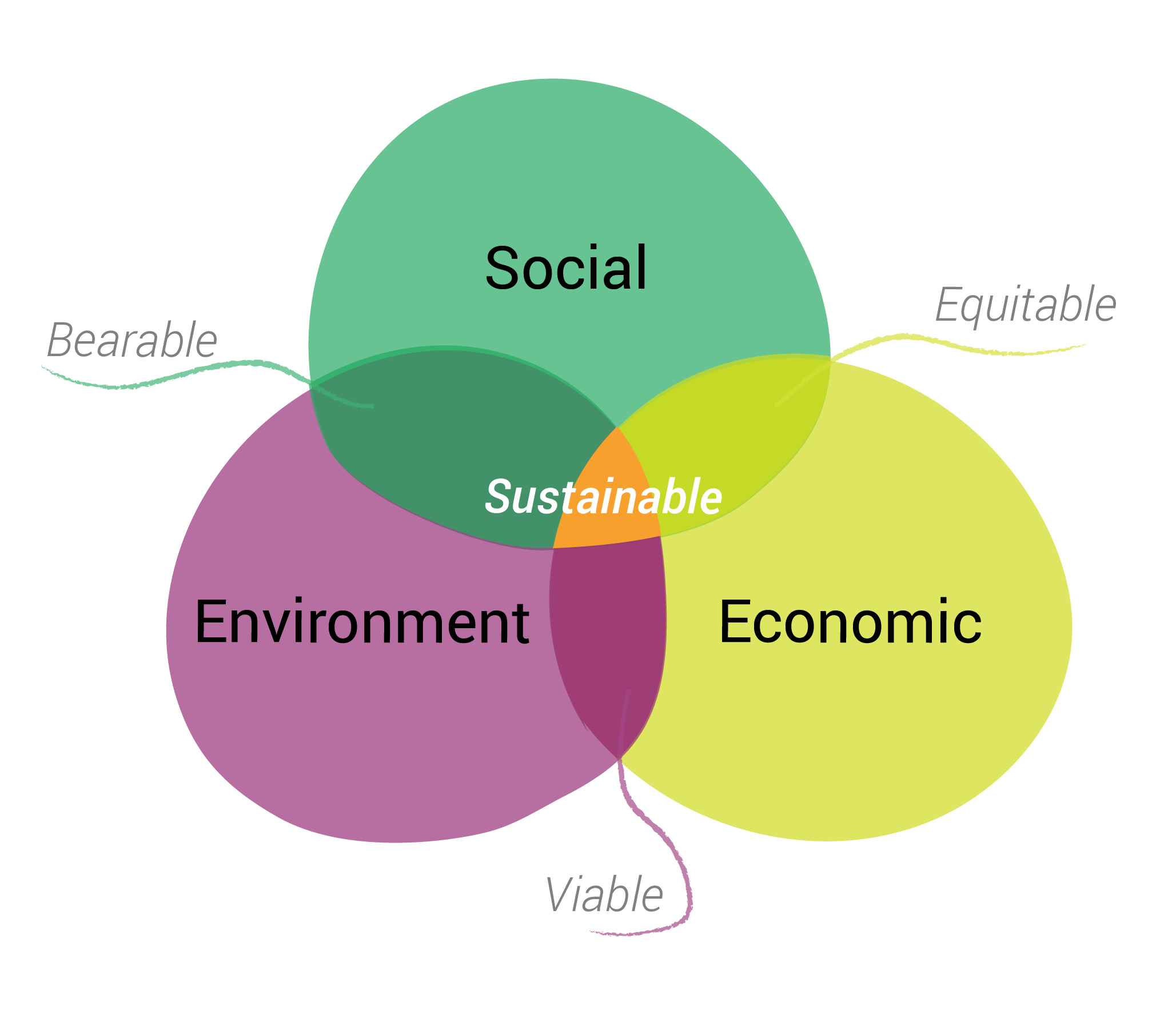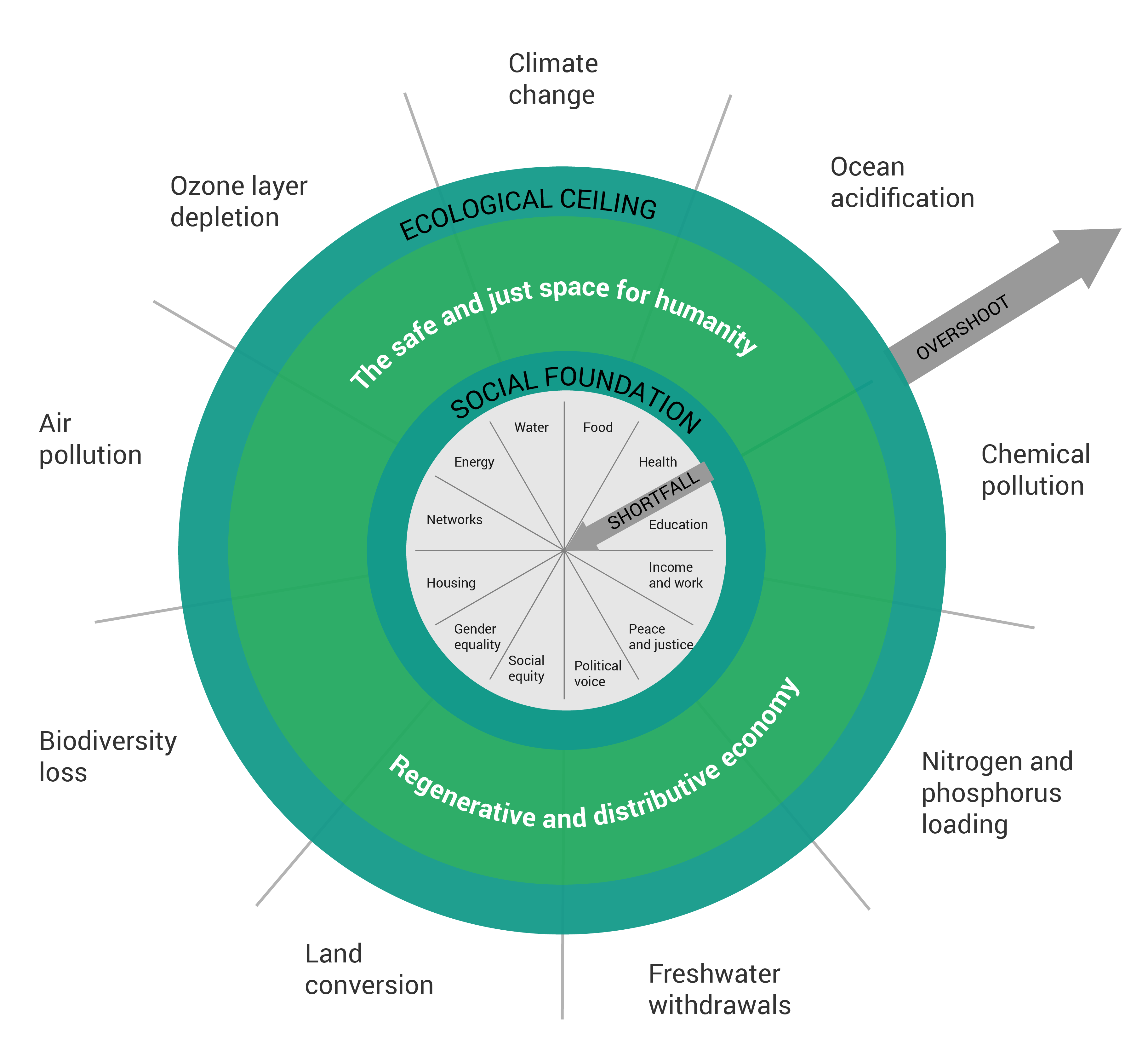Module 2: Meeting the needs of the future
A digital device can have positive or negative economic, social and environmental impacts at each stage in its life cycle, starting from the energy and natural resources used to make it, through to its usefulness, and ending when it becomes e-waste. Sustainability means minimising the negative impacts and maximising the positive impacts.
What is sustainable development?
Sustainable development is about meeting “the needs of the present without compromising the ability of future generations to meet their own needs.”[1] This means supporting economic development while simultaneously sustaining the natural resources and ecosystems on which the economy and society depend.
Development is not the same as “growth”, which has been equated with environmental degradation, and what is known as the “tragedy of the commons”.[2] The idea of sustainable development reflects the need for a balance between economy, people and nature. It was discussed in the Club of Rome report Limits to Growth[3] as early as 1972, and the UN report Our Common Future[4] in 1987. The sustainability of human development and progress is dependent on reconnecting to the biosphere and essential ecosystems.[5]
The 2005 World Summit[6] identified sustainable development goals with three pillars: economic development, social development and environmental protection. As Figure 4 shows, key adjectives describe their intersections – “bearable”, “equitable” and “viable” – and it is only when all three intersect that sustainability can be achieved.
Figure 4: Scheme of sustainable development: at the confluence of three constituent parts. (Wikipedia: Sustainable_development)
The achievement of the UN’s Sustainable Development Goals (SDGs) by 2030 depends on addressing all three pillars of sustainability. The SDGs were adopted in 2015 as “a universal call to action to end poverty, protect the planet and ensure that all people enjoy peace and prosperity by 2030.”
The digital world is part of the problem and may be part of the solution.A digital device has economic, social and environmental impacts at each stage in its life cycle, starting from energy and natural resource consumption and ending in e-waste. There are many negative impacts of digital devices. For example, many communities in the global South suffer from the negative effects of extractivism (or the mining and extraction of natural resources) or the dumping of e-waste. In contrast, information and communications technologies (ICTs) can enable efficiencies in social and economic life through digital solutions that can improve energy efficiency, inventory management, and a reduction in travel and transportation (e.g. telework and videoconferencing, substituting physical products like books with digital information). This capacity is referred to as “second order” or “enablement” effects. |
The SDGs and the internetThe Sustainable Development Goals (SDGs) have numerous objectives linked to reduced inequality. ICTs and digitisation can contribute to the achievement of all the SDGs. In fact, even if the internet is less visible in the SDGs than it should be, there are goals with direct implications: 7: “Affordable and clean energy”, which requires ICTs to be used in things like solar and wind energy, and isolated micro-grids; 9: “Industry, innovation and infrastructure”, with networking and computing as key infrastructures; 11: “Sustainable cities and communities”, where ICTs can be used to help achieve them; 12: “Responsible consumption and production”, which relates to the circular economy of digital devices; and 13: “Climate action”, where ICTs can be used to support data sharing, campaigning and the coordination required for climate action. |
What is a “safe and just space for people on the planet”?
Figure 5: Doughnut economics
The diagram in Figure 5 is a visual framework showing the viable space for sustainable development. Shaped like a doughnut (or lifebelt), it combines the concept of “planetary boundaries” with the complementary concept of “social boundaries”.[7] The centre hole of the model depicts the proportion of people that lack access to essential needs (such as health care, education, work, etc.), while the outer “crust” represents the ecological ceilings (planetary boundaries) that life depends on and which should not be exceeded. There is a region within the planetary and social boundaries that is considered viable for a regenerative and distributive economy.
We need to radically improve our relationship with nature, and that requires rethinking many decisions and reorganising many processes. The diagram shows that there is a need to address environmental, economic and societal needs for a sustainable future. We also have to ensure open ways to participate, considering locality. One key change we need to promote is circularity and the so-called “circular economy”.
References
[1] United Nations World Commission on Environment and Development. (1987). Our Common Future. http://www.un-documents.net/our-common-future.pdf
[2] Hardin, G. (1968). The Tragedy of the Commons. Science, 162(3859), 1243-1248. https://www.science.org/doi/10.1126/science.162.3859.1243
[3] Meadows, D. H., Meadows, D. L., Randers, J., & Behrens, W. W. (1972). The Limits to Growth: A Report for the Club of Rome's Project on the Predicament of Mankind. Universe Books. https://collections.dartmouth.edu/teitexts/meadows/diplomatic/meadows_ltg-diplomatic.html
[4] United Nations World Commission on Environment and Development. (1987). Op. cit.
[5] Folke, C., et al. (2011). Reconnecting to the Biosphere. Ambio, 40. https://doi.org/10.1007/s13280-011-0184-y
[6] United Nations General Assembly. (2005). 2005 World Summit Outcome. Resolution A/60/1, adopted by the General Assembly on 15 September 2005. https://www.un.org/en/development/desa/population/migration/generalassembly/docs/globalcompact/A_RES_60_1.pdf
[7] Raworth, K. (2012). A Safe and Just Space for Humanity: Can we live within the doughnut? Oxfam. https://policy-practice.oxfam.org/resources/a-safe-and-just-space-for-humanity-can-we-live-within-the-doughnut-210490



No Comments